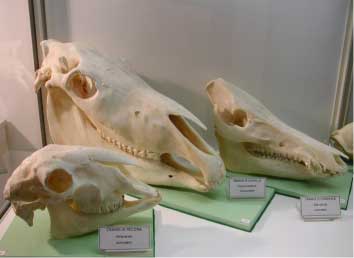
In the entrance next to the giant model of the flying stag beetle, chosen as the Museum’s emblem, there is a display case on Osteology (the study of bones), showing the different skeletal structure of various groups of vertebrates. The skeleton of a bird, for example, can be compared with that of a mammal, noticing the different kinds of feet (plantigrade, digitigrade or unguligrade), types of skull (erbivore, carnivore or insect eater) and cross section of the horns of a roe deer (plenicorn) compared with a chamois (cavicorn).
The collection of vertebrates can be considered the “heart” of the Museum and this alone shows the abundance of fauna in the area.
This collection, as with the others in the Museum (the fungi, wood specimens, snails and insects), has been organised for display systematically. Each object has a card with the following information: its scientific name in Italian, English and German, its name in dialect, the area it can be found in and the main characteristics of the family it belongs to. At the base of the cabinets and on the walls there are charts and pictures to aid in understanding the fauna groups and their ecological adaptation.